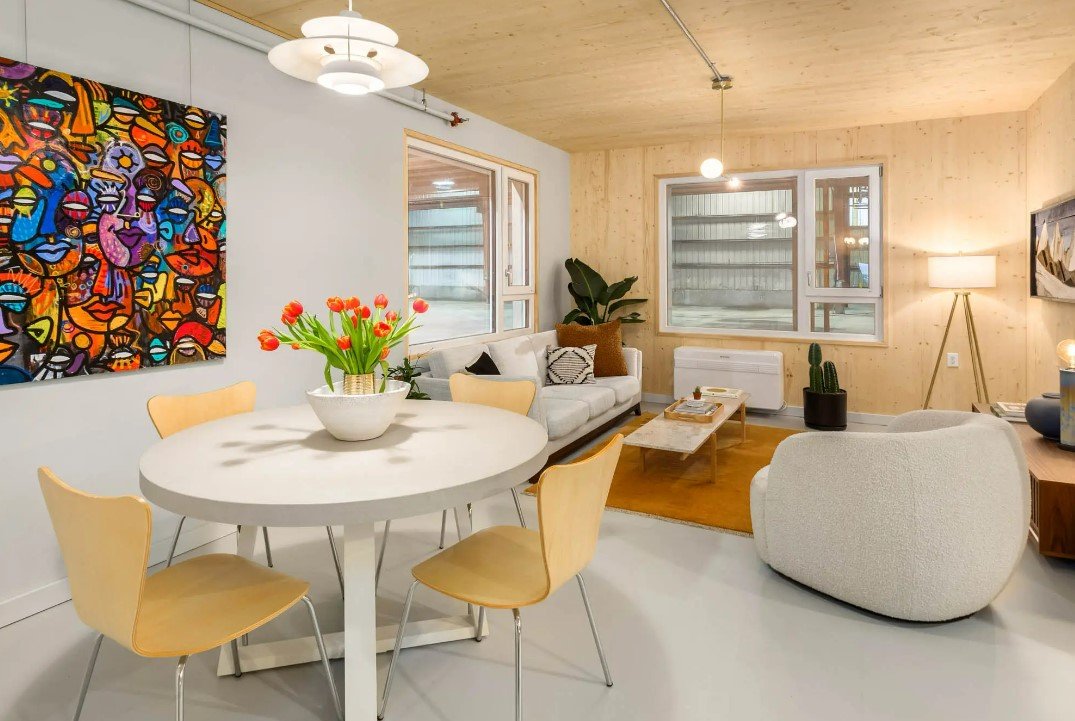Cross-Laminated Timber and Forterra's Forest to Home Initiative
Forterra’s MOD PRO unit, the first modular mass timber unit of its kind. Image courtesy of Forterra
The Ivory Innovations team visited Forterra, headquartered in Seattle, for a tour of their new MOD PRO unit and to see the site of the future Darrington Wood Innovation Center. Learn what we discovered about Cross-Laminated Timber (CLT) and how Forterra’s Forest to Home Initiative is spurring an innovation ecosystem for CLT in the Seattle area.
What is CLT? What is mass timber?
CLT consists of planks (or lamellas) of sawn and layered wood, glued or mechanically fastened, where each layer is oriented perpendicular to the previous with at least three layers. CLT could also come in five or eight layers, depending on the required size and strength. CLT is usually constructed from softwood species such as spruce, although it can be manufactured from larch, fir, douglas fir, pine, or other timbers. CLT is usually manufactured as panels to be used in walls and floors.
Image courtesy of Housing Access Coalition
However, CLT is just one product within a larger category of wood innovations known as “mass timber.” For example, another material, Glulam, is used for structural elements like columns and beams. The main difference between CLT and Glulam is that Glulam timber layers are laid in the same direction to provide a very strong one-dimension and another weak dimension. In contrast, CLT Cross layers provide two-dimensional strengths but are not as strong as Glulam.
Source: cbi.eu
What are the advantages of using CLT?
Sustainable material because it comes from a renewable source and captures carbon. CLT generally does not require burning fossil fuels to prepare the material, which also reduces CO2 emissions.
Ease of installation.
High strength to weight ratio. The CLT strength can exceed the strength of concrete and steel.
Shorter construction time as the panels are pre-fabricated with openings in place.
Fire-resistant because the outer layer, once exposed to high temperatures, will form a layer to protect the inner part of the CLT and maintain its structural integrity.
Reduces the structure weight, which reduces the building foundation requirements and costs.
However, there may be several disadvantages to using CLT given that it is a “newer” material for many builders in the US:
High up-front construction costs.
Higher design fees.
Profits may accrue at the end of the building life cycle, as the salvage values of CLT structures are expected to exceed those of similar concrete buildings.
What is the market for CLT products in the US?
According to a study conducted by imarc group, the 2021 CLT market in North America is valued at $129.3 million and is expected to grow to $360.2 million in 2027. The slow adoption of CLT in the US can be related to many reasons and circumstances, such as:
There is a limited supply of CLT products in the US, which results in high premiums to get the material.
Building codes in the US do not utilize the full potential of CLT; thus, there is no justification for using CLT while the upfront cost is higher.
Lack of training for architects, city inspectors, and builders. Knowledgeable companies in CLT design and construction add a high premium to their services.
Disincentives for developers and builders given higher upfront costs (even though there may be profits at the end of the building’s life). For example, a study performed on a 12-story, 8,360 square meters mass timber building in Portland, Oregon found that the up-front cost of using CLT was 26% higher than steel and concrete. However, there was a decrease of 2.4% in the total life cycle cost of the building.
Table 4 of the study shows that upfront costs are offset by the end-of-life salvage value of the CLT building
Who supplies CLT to developers? How does Forterra’s Forest to Home Initiative address supply gaps?
The CLT market in the United States is nascent but growing: there are a few major suppliers such as SmartLam, StructurLam, DR Johnson, and Sterling. However, there is ample room for additional suppliers to enter the market — which Forterra (an Ivory Prize Finalist in 2019 and 2022) is doing by supporting the Darrington Wood Innovation Center and through their Forest to Home Initiative.
Forterra’s focus on housing evolved from their roots as a conservation organization in the Pacific Northwest. Their Forest to Home Initiative fits their mission of scaling land-based solutions where people and nature thriving together in a place where everyone belongs. More specifically:
Forterra’s Forest to Home vision begins with responsibly harvested local timber. Timber is milled and processed into cross-laminated timber, or CLT. This CLT is the structural basis for the modular homes that will be assembled on the 94-acres Darrington Wood Innovation Center campus before being transported, nearly complete, to nearby building sites in Washington state.
Forest to Home is Forterra’s answer for creating long-term affordable housing, wealth and social equity through home ownership. It brings attainable homes to overburdened communities, creates new jobs for rural timber towns, replaces traditional carbon-intensive building practices and materials and—under a limited equity co-op ownership financial structure—alleviates the initial financial burden for homebuyers and keeps them affordable over the long haul.
Forterra’s holistic focus on affordability and equity from the very start of housing construction resonated with our judges during the 2022 Ivory Prize evaluations process. We were pleased to tour their mass timber modular unit prototype in Seattle and look forward to celebrating Forterra’s progress as they continue to put innovation into action.
From left to right: the site of the future Darrington Wood Innovation Center; Forterra’s MODPRO unit in construction, as a module, and the living room inside.
You can learn more about Forterra’s Forest to Home Initiative in the video below or on their website.
By Amro Al-Nimri and Jenna Louie








